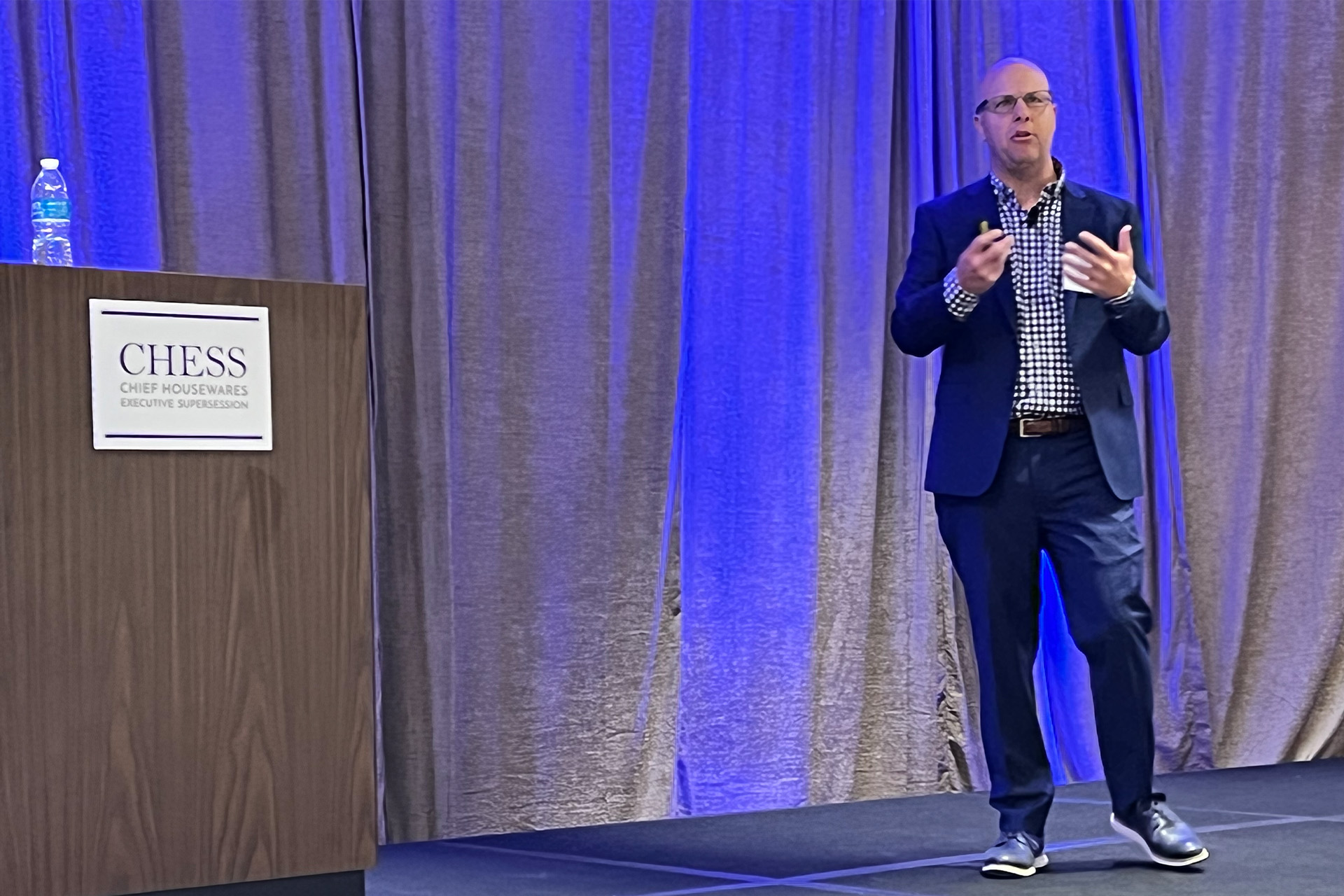The IHA Chief Housewares Executive SuperSession returned this week as an in-person education and networking event for home and housewares industry leaders.
Day two of the event at the Hilton Rosemont O’Hare examined how key retailers have weathered the pandemic from a credit risk standpoint; how to optimizes expansion into global e-commerce marketplaces; the evolving relationship between pandemic-influenced consumers and retailers heading into the holidays and 2022; and how to create brands stories that win the hearts of consumers.
Retail is Alive and Well

Dennis Cantalupo, partner, Riemer+ and CEO, Pulse Ratings, reviewed how the pandemic impacted the financial health and credit risk associated with key housewares retailers.
Cantalupo also previewed the launch of the Housewares Credit Group, a new collaborative service offering IHA members subscription access to financial analysis on retailers by Reimer and in-depth credit rating reports by Pulse Ratings.
Starting the session to open day two of CHESS with a look at department stores, including off-prices specialists, Cantalupo said the channel benefitted from several pandemic-influenced factors: including pent-up consumer demand, a strong home product focus and some $6 billion of available market share vacated by store closings across the retail landscape.
He said many traditional department store operators also registered improved profitability enabled by higher margins because fewer markdowns were required in such a high-demand, limited-supply period.
“This has helped these retailers understand what efficient inventory management looks like,” he said.”
The healthiest retailers heading into the pandemic, not surprisingly, are coming out of the pandemic in the best shape, Cantalupo said.
He noted Wayfair and At Home as among the home product retailers struggling before the pandemic that posted solid EBITDA gains on surging sales during the pandemic. He said it will be important to watch if these retailers can sustain operating income improvement as sales ease.
Cantalupo cited Macy’s for its stable, short-term credit outlook. He noted the retailer’s recovering EBIDTA, reduced debt and continuing ability to borrow against its real estate. He also spotlighted Nordstrom as among the recovering department store retailers that have improved credit risk during the pandemic with an effective omnichannel program, reduced debt and positive cash flow.
On Bed Bath & Beyond, Cantalupo said the retailer, despite alarming second-quarter financials last week, from a credit risk standpoint still offers sufficient liquidity, is paying suppliers on schedule and has manageable debt. He said the retailer still has “plenty of runway to make the changes.”
Expanding Your Reach: Leveraging Digital to Your Advantage for International Expansion

Digital acceleration over the past 18 months has lowered the barriers to allow companies to enter international markets and grow outside the US.
John LeBaron, chief revenue officer of Pattern, an e-commerce acceleration company, discussed the newest digital platforms and strategies companies can use for international growth during the CHESS session, “Expanding Your Reach: Leveraging Digital to Your Advantage for International Experience.”
LeBaron started by talking about the executive dilemma, direct-to-consumer, marketplace and competency complexities.
He outlined the competencies required to win on global e-commerce:
- Insights: Market share, digital shelf analytics, competitive trends, conversion rates, category trends
- Traffic: SEO, keyword research, advertising, automated bidding, product destiny
- Content: Images, video, bullets, content, reviews
- Protect: Price monitoring, brand control, removing unauthorized sellers, buying box control, mapping enforcement
- Logistics: Fulfillment, returns, forecasting, third-party networks, crossdocking
Continuing, to help the brands master these e-commerce competencies, LeBaron shared solutions for each:
- Insights: Consolidate data through omnichannel visibility, know what to do next, compare market share vs. competitors
- Traffic: Increase traffic through automating advertising, optimizing product listings for SEO and increasing ROAs
- Content: Boost conversion through optimizing content, building brand credibility and maintaining omnichannel brand consistency
- Protect: Monitor price and sellers by winning the Buy Box, decreasing MAP violators and stabilizing pricing
- Logistics: Sell everywhere through always being in stock, expanding fulfillment capabilities and reducing shipping costs
Lastly, LeBaron discussed that there are Amazon opportunities in Europe, with its logistics and fulfillment operations holding up well to spikes in demand in most European markets.
Three options to scale on Amazon internationally include:
- Amazon FBA Export: Product availability via Amazon.com to consumers available in global markets. The brand gains access to international customers searching Amazon with no product registration require and an easy approach to monitoring demand. However, products are not listed on local Amazon storefronts and no Prime shipping is available.
- Amazon Global Store: These localized listings are supported by dedicated inventory and fulfilled by a merchant from the US. The brand gains access to local customers, local advertising and SEO optimization. However, products are being shipped from the US and the customer pays for shipping.
- Amazon Local Presence: Localized listing fulfilled by Amazon in the region. The brand gains fast shipping, local advertising and SEO optimization and in-region customer support. However, product registrations are often required and subject to taxes, duties and tariffs.
Revisiting Post-COVID Retailing

What’s around the corner for consumer demand?
Don Unser, chief retail strategist of The NPD Group, answered this question by discussing consumer purchasing across many industries in Revisiting Post-Covid Retailing. Comparing 2021 discretionary spending with 2019 and 2020, Unser identified key topics that will define the U. S. retail market ahead.
- Work from Home: 10-25 million NEW workers at home. NPD estimates 20-35% of all workers will work part-time or full time at home, representing 8-18% of the U.S. workforce
- Experience Spend is Back: Entertainment and travel went to zero and are recovering.
- Time Shifts: Consumers will return to some pre-pandemic routines
- Delta Variant: Biggest question on returning to office and schools
- Holiday Outlook: Strong demand, increase over 2020.
- E-commerce Levels Capping Out: Volumes and growth pulling back from 2020 highs
- Average Sales Price Growth: Dollars outpacing unit sales in most general merchandise industries
Spending in 2020 was impacted by stimulus checks, eviction moratoria, child tax credits, unemployment benefits and student loan forbearance, Unser said. For some households, these benefits increased savings, which peaked in April 2020. Many consumers used stimulus money to reduce credit card debt to the lowest level since 2009.
Retailers are training consumers to pay full price, rethinking discount strategies and offering fewer promotions on limited assortments, Unser noted. Prices have jumped for housing, new and used cars, large appliances and computers.
Brick and mortar retail sales are strong, notably influenced by BOPIS (buy online, pick up in-store). Year over year e-commerce sales were negative for the first time in 20 years, Unser revealed.
Additional topics to monitor in the coming months, according to Unser:
- Strong momentum for holiday sales.
- Possible Q1 or Q2 softening
- Elevated spending continues
- Supply chain problems continue until demand softens
- Urban migration impact
- Channel consolidations
- Innovation will drive growth
Guidance for 2022
Unser said home and housewares executives planning for next year should consider the following:
- What will be the future demand levels, and what will signal change?
- Is a company’s product distribution strategy optimal for the future?
- What are the structural shifts in retail for q company’s region and industry, and where does its brand fit?
- Is a company’s brand gaining customers or losing them? What are the core drivers?
- Who is “best in class” in adjacent industries and why?
- Brands: Does the consumer want a direct relationship with a company’s brand, and what is the brand’s value add?
- Retailers: How can a retailer be the place where the best brands want to sell?
- How can a company innovate to delight customers?
Tell Your Brand Stories and Create Customer Karma for Life

“We are all in the business of feelings. Create a value-based company that wins hearts,” urged ZenMango CEO Arjun Sen told home and housewares executives to conclude the 2021 CHESS conference.
Sen illustrated the aspects and impacts of telling compelling stories to build customer loyalty and increase sales.
He discussed types of stories based upon the founder, company origin, product, team or giving back to the community. Such stories, he explained, impact team members to believe, connect and inspire; affirm expectations of current customers, and intrigue future customers with a reason to try your product or service.
The most powerful brand stories are authentic, verifiable, memorable, relatable, aspirational, current and identify “only you,” Sen said.
When creating your stories, he urged business leaders to focus on these questions: “What? “So What?” and “Now What?” A story should be short and crisp, universal and leave room for imagination, he said. Customers ask themselves, “What’s in for me?” Be sure, Sen stressed, to offer opportunities for listeners to feel they are part of the story.
Stories are everywhere waiting to be discovered, Sen said. Any company has untold stories –recall responses to unexpected events and problems solved by its team members. Build on these experiences, Sen added, to make a company and brand relevant to a user’s life. Recognize that a story will impact one person at a time and that each product is bought by one person, Sen continued. Purchasers want products that make them feel special or solve a need, he said.
Every business has a billion-dollar idea, Sen emphasized, offering several
- Focus on what drives emotions.
- Marketing does not make a brand—it makes a promise.
- Listen to customers tell you their pain points. Better yet, step into their place.
- Follow customer journeys to experience their pain.
Noting the difference between telling a story and living it, Sen concluded by urging companies to begin with these steps: “Be, Think, Feel, Act. You’ll create customer value for life.”





